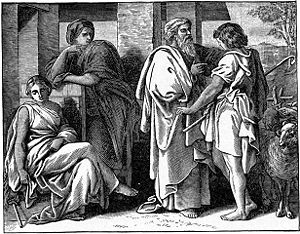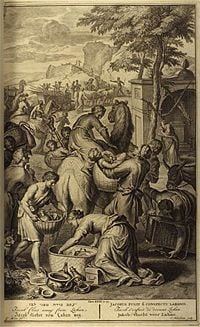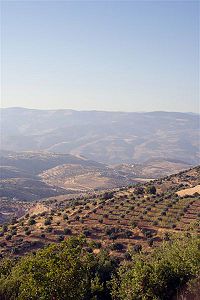Leah
 From Nwe
From Nwe Leah (לֵאָה; Lea or Lēāh; "weary, tired") was the first wife of the Hebrew patriarch Jacob and foremother of six of the Twelve Tribes of Israel described in the Book of Genesis.
Leah was wed to Jacob through an act of deception by her father Laban. Jacob soon married her beautiful sister Rachel as well, and Leah suffered for years, feeling unloved compared to her younger sibling. Yet, she was a loyal wife and fertile mother. She also faithfully followed Jacob, risking her father's wrath, when Jacob was suddenly called by God to leave Haran and return to Canaan.
Leah receives much praise in rabbinical tradition for her role as the ancestor of kings, prophets, priest, and sages as well as for her life of prayer, which merited her being married to the father of the Israelites. She was the mother of Judah, and thus the foremother of the Jewish people in general. Traditionally, it is through Leah's lineage that the messiah will appear, and in Christian faith, she is seen as the ancestor of Jesus Christ.
Biblical narrative

In the Biblical account, Jacob travels to the hometown of Laban—the brother of his mother Rebekah—to avoid being killed by his brother Esau, and also to find a wife. At a well used to water the local flocks, he encounters Laban's younger daughter Rachel tending her father's sheep, and decides to marry her. He proceeds to work seven years for Laban in order to marry Rachel, after the seven years are over, a great feast is held.
"In the morning, Leah"
Laban, however, switches Rachel for Leah, and it is thus Leah who spends the wedding night with Jacob. The text does not explain how such a thing could transpire, except to say, "in the morning, (it was) Leah!" Laban justifies himself on the grounds that it is uncustomary to give the younger daughter in marriage before the older one (Gen. 29:16-30). He offers to give Rachel to Jacob in marriage in return for another seven years of work. Jacob accepts, spending the week with Leah exclusively and then marrying Rachel as well.
Few physical details are given concerning Leah's appearance. While Rachel is described as "beautiful" Leah's eyes are described with a word (רכות) that could mean either "tender" (as in delicate and soft) or "weak."
Fertile, but unloved
In the early years of the sisters' marriage, it is obvious that Jacob loves Rachel more than Leah. However, God sympathizes with Leah and gives her four sons in quick succession. These are Reuben, Simeon, Levi, and Judah (Gen. 29:31-35). We get a glimpse into Leah's character by her responses—each of which is also a pun on the baby's name—to her successive births:
- Reuben—"It is because the Lord has seen my misery. Surely my husband will love me now."
- Simeon—"Because the Lord heard that I am not loved, he gave me this one too."
- Levi—"Now at last my husband will become attached to me, because I have borne him three sons."
- Judah—"This time I will praise the Lord."
The text here tells us that at this time, Leah stops having children, although later we find out that the situation is only temporary.
Rachel, seeing that she is still unable to conceive, offers her handmaid Bilhah as a third wife to Jacob. She names and raises the two sons—Dan and Napthali that Bilhah bears. Leah responds by offering her handmaid Zilpah as a fourth wife to Jacob. She names and raises the two sons—Gad ("What good fortune!") and Asher ("How happy I am!") that Zilpah bears.
One day, Leah's firstborn, Reuben, returns from the field with mandrakes for his mother. Rachel, believing the roots will solve her fertility problem, asks for some of the roots. Leah responds angrily to her rival: "Wasn't it enough that you took away my husband? Will you take my son's mandrakes too?" (Gen. 30:15). Rachel offers to trade her night with their husband in return for the mandrakes. Leah agrees, and that night she conceives Issachar ("God has rewarded me), and she also gives birth to Zebulun. After this sixth son, the long suffering Leah declares: "This time my husband will treat me with honor."
Finally, after six males, Leah finally gives birth to a daughter, Dinah.
After that, it is said that God remembers Rachel and gives her a son, Joseph, saying "God has taken away my disgrace."
Leaving home
During all this time, about 14 years, Leah had been living on her father's land. However, when it came time for Jacob to leave, Laban insisted on still another seven years labor from him. In the twenty-first year, God called Jacob to return to Canaan. Meanwhile, during the last seven years, Jacob had cleverly built up his own flocks while Laban's had not done nearly so well. Jacob sent for Leah and Rachel and shared God's revelation with them:
- I have seen all that Laban has been doing to you. I am the God of Bethel, where you anointed a pillar and where you made a vow to me. Now leave this land at once and go back to your native land. (Gen. 31:12-13)
Jacob planed to depart immediately, knowing that Laban would accuse him of theft and breaking their agreement. Leah and Rachel replied:
- Do we still have any share in the inheritance of our father's estate? Does he not regard us as foreigners? Not only has he sold us, but he has used up what was paid for us. Surely all the wealth that God took away from our father belongs to us and our children. So do whatever God has told you. (Gen. 31:14-15)
Leah quickly gathered her children and belongings and joined Jacob—together with Joseph and the slaves—to leave for Canaan. The families apparently did not live in immediate proximity, for only after three days does Laban realize the large caravan—not to mention his daughters and grandchildren—had gone. He did not overtake the group until they had reached the hill country of Gilead, to the east of the Jordan River.
Although the scene is ripe for bloodshed, it is said that God spoke to Laban and warned him not to harm Jacob. A tense drama unfolded as Laban searched for his precious household images which Rachel had stolen from him, but they are not discovered. Finally, Laban offers a covenant of peace between him and Jacob, saying:
- The women are my daughters, the children are my children, and the flocks are my flocks. All you see is mine. Yet what can I do today about these daughters of mine, or about the children they have borne? Come now, let's make a covenant, you and I, and let it serve as a witness between us. (Gen. 31:43-44)
Jacob agrees to the covenant of peace, indicating an ancient religious bond between him and Laban going back to the time of their grandfather Terah, saying: "May the God of Abraham and the God of Nahor, the God of their father, judge between us." Jacob set up a sacred pillar to commemorate the meeting and mark a boundary between his lands and Laban's. They share a sacrificial feast. Leah and her children, together with Rachel and Joseph, then kiss their father goodbye for the last time.
In Canaan
Despite her giving Jacob six sons and a daughter, Leah continues to play the role of lesser wife to Rachel. Thus when Jacob stations his family in ranks to meet the possible threat of Esau's approach, he placed the female slaves and their children in front, making them the most vulnerable to any harm, followed by Leah and her children, and last of all Rachel and Joseph (Gen. 33:2).
Even after Jacob's successful reunion with Esau and the settling of their family in Shechem, Leah's trials are not over. Her beloved daughter Dinar is raped by the son of Shechem's king, Hamor. Although the young perpetrator, himself named Shechem, tries to make things right by marrying her, Leah's sons are "filled with grief and fury." Jacob agrees to the marriage, but his sons add the stipulation that the Shechemites must be circumcised first. While the men of the town are recovering from their wounds, Leah's sons Simeon and Levi attack and carry out a mass slaughter. Having alienated the neighboring people by this behavior, the family then moves to Bethel. On the way, Rachel has a second son, Benjamin, but she dies giving birth to him. Thus Leah has finally achieved the status of primary wife, but apparently without ever fully reconciling with her younger sister.
Death and Legacy
Leah is traditionally thought to be buried in the Cave of the Patriarchs in Hebron. According to Genesis 49:32, Jacob states, "There Abraham and his wife Sarah were buried, there Isaac and his wife Rebekah were buried, and there I buried Leah."
Leah's descendants are listed in Genesis 35:23 and again in Genesis 46:15, while her adopted descendants through Zilpah are given in Genesis 35:26 and Genesis 46:18. As the mother of Judah, she became the foremother of the Tribe of Judah, and thus virtually all Jews. She is also the foremother of all of the Davidic kings of the Kingdom of Judah. Since it is traditionally believed that the messiah will be descended from Judah, this would make Leah the foremother of the messiah.
Rabinnical views
According to the medieval sage Rashi, Leah was originally destined to marry Jacob's twin brother, Esau. People would say, "Laban has two daughters and his sister, Rebekah, has two sons. The older daughter (Leah) will marry the older son (Esau), and the younger daughter (Rachel) will marry the younger son (Jacob)." Hearing this, Leah spent most of her time weeping and praying to God to change her destined mate. It was from this weeping that her eyes became "soft." Hearkening to her tears and prayers, God allowed her to marry Jacob even before Rachel did.
Another tradition holds that Rachel and Leah were twin sisters. They were 14 years old when Jacob came to Haran. Thus they were both 21 at the time of their marriage (Seder 'Olam Rabbah 2). Leah is called the elder sister because royalty and the priesthood remained permanently with her descendants, while they were held only temporarily by Rachel's—royalty with Joseph and Saul, and the priesthood with the tabernacle of Shiloh (Gen. R. 70:15). However they were both ancestresses of kings, heroes, prophets, judges, and conquerors (ibid.; Tan., Wayeẓe, 13).
Classical Hassidic texts explain the sisters' rivalry as more than mere marital jealousy. Each woman desired to grow spiritually in her service of God, and therefore sought closeness to the righteous Jacob who was seen as God's personal emissary in this world. Each woman also continually questioned whether she was doing enough in her personal efforts toward increased spirituality, and would use the other's example to spur herself on. Rachel envied Leah's tearful prayers, by which she merited marrying Jacob and bearing six of his 12 sons. Leah envied Rachel's traits of humility and acquiescence, which were displayed when she saw Laban bringing Leah in marriage to Jacob instead of herself, yet remained silent.
Modern views
Critical scholars note that Leah's story, like that of most of the women in Genesis, is told by "J," the "Yahwist" source identified in the documentary hypothesis. Like several of J's women, Leah is not afraid to take matters into her own hands. Like Judah's wife Tamar, a few chapters later, she disguises herself and pretends to be someone else in order have sex and conceive children with an unsuspecting man. The fact that she is described by J as leaving off child-bearing after the birth of Judah is contracted by an Elohist ("E") account of her bargaining with Rachel for a night with the husband (Jacob) has taken from her. Further evidence of at least two sources in the story of Leah is found in the dual genealogies, slightly divergent from one another, mentioned above.
Feminist theologians point to the story of Leah and Rachel as evidence of the injustice of the patriarchal society, which the Bible describes as ordained by God. Leah is forced by her father, Laban, into a deceptive act of sex without love, resulting in an unhappy marriage with a man who loved her sister, not Leah herself. Furthermore, Leah's value is counted strictly in terms of her ability to bear children for Jacob. She has no hope in life except that by providing children for this man who does not love her, he may finally come to show her some degree of honor and affection.
Unification theology sees Leah's position as elder sister being analogous to Cain's position in relation to Abel. Her feeling of being unloved by Jacob was analogous to Cain's feelings of rejection after his offering was not accepted by God, and to Lucifer's feelings of being loved less by God after the creation of Adam and Eve. Leah partially succeeded in this course by acting as a faithful wife to Jacob and strong mother to her many children. However, it was also her responsibility to bring her own children into unity and cooperation with Rachel and her children. This mission, unfortunately, was left unaccomplished. This ultimately resulted in the division of her and Rachel's descendants into the two kingdoms of Israel and Judah. Because of Leah and Rachel's unfulfilled task, at the time of Jesus, two providential women had to complete their mission. To accomplish this, John the Baptist's mother Elizabeth stood in Leah's position, while Mary represented the position of Rachel (See Unification Aspects page of this article).
References
ISBN links support NWE through referral fees
- Bellis, Alice Ogden. Helpmates, Harlots, and Heroes: Women's Stories in the Hebrew Bible. Westminster John Knox Press, 1994. ISBN 978-0664254308
- Bloom, Harold. The Book of J. Grove Press, 2005. ISBN 0802141919
- Card, Orson Scott. Rachel and Leah: Women of Genesis (Novel). Forge Books; New Ed edition, 2005. ISBN 978-0765341297
- Davis, Cynthia. Beloved Leah (Novel). Americana Publishing, 2001. ISBN 978-0739429426
- Fischbein, Jessie. Infertility in the Bible: How The Matriarchs Changed Their Fate; How You Can Too. Devora Publishing, 2005. ISBN 978-1932687347
- Frymer-Kensky, Tikva. Reading the Women of the Bible: A New Interpretation of Their Stories. Schocken, 2002. ISBN 978-0805241211
- Kirsch, Jonathan. The Harlot By the Side of the Road. Ballantine Books, 1998. ISBN 0345418824
- Russell, Letty M. Feminist Interpretation of the Bible. Westminster John Knox Press, 1985. ISBN 978-0664246396
Credits
New World Encyclopedia writers and editors rewrote and completed the Wikipedia article in accordance with New World Encyclopedia standards. This article abides by terms of the Creative Commons CC-by-sa 3.0 License (CC-by-sa), which may be used and disseminated with proper attribution. Credit is due under the terms of this license that can reference both the New World Encyclopedia contributors and the selfless volunteer contributors of the Wikimedia Foundation. To cite this article click here for a list of acceptable citing formats.The history of earlier contributions by wikipedians is accessible to researchers here:
The history of this article since it was imported to New World Encyclopedia:
Note: Some restrictions may apply to use of individual images which are separately licensed.
↧ Download as ZWI file | Last modified: 02/03/2023 21:44:55 | 1 views
☰ Source: https://www.newworldencyclopedia.org/entry/Leah | License: CC BY-SA 3.0
 ZWI signed:
ZWI signed:


 KSF
KSF